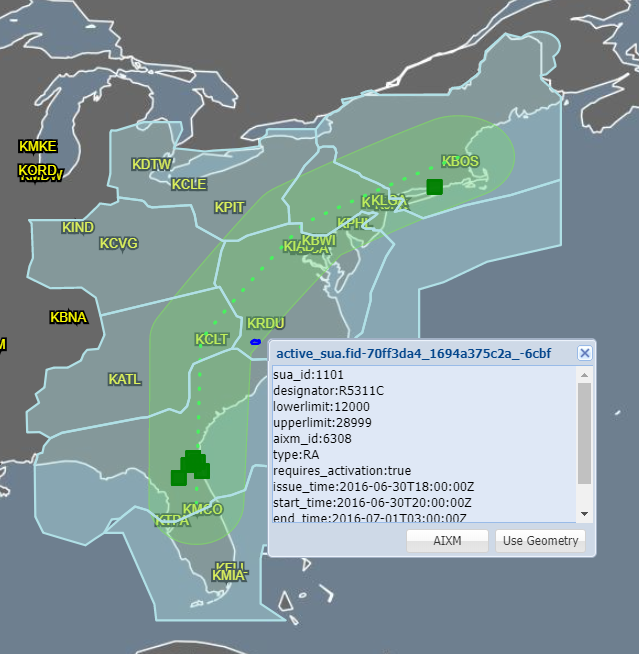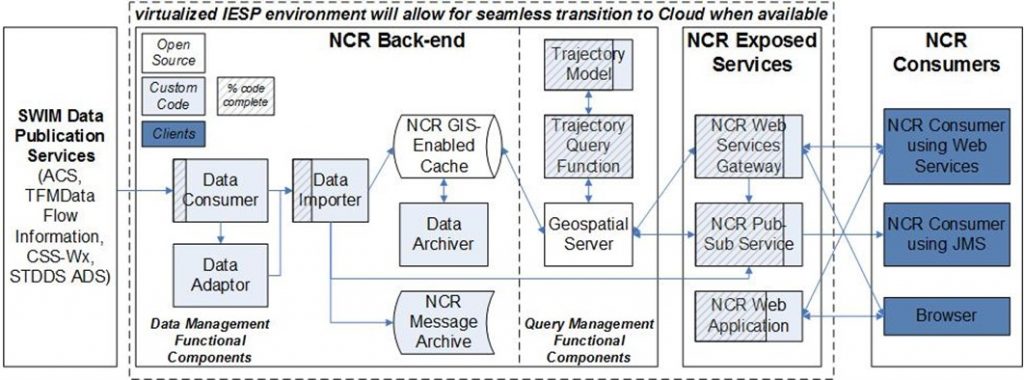NCR Common Reference | NAS Information Exchange

Take Our Content to Go
The Need for Integrated NAS Data
According to the Volpe Center1, on any given day, nearly five terabytes of data on flight movements, weather data, air traffic flow constraints, NOTAMs, and more move across the Federal Aviation Administration’s (FAA) System Wide Information Management (SWIM) enterprise between data producers and end-users.
While this data unlocks potential for enhanced operational awareness and analysis, its sheer volume can create challenges for airline operators and other SWIM data users who must drill down and find the relevant information.2
The FAA needed an aviation technology partner that had substantial expertise in fusing data streams like this. The FAA turned to Mosaic ATM, a leading aviation technology company, to build this data integration capability. Mosaic developed a data exchange system to assist the FAA SWIM program in delivering the correct information, to the right users, at the right time.

NCR Common Reference Background
NCR uses Service Oriented Architecture (SOA) concepts to provide integrated NAS data products for distribution to both NAS and non-NAS systems. NCR consumes data from other System Wide Information Management (SWIM)-compliant web services and legacy data sources if unavailable via SWIM and aggregates and publishes the data to consumers in response to cross-domain queries that can include a broad range of filters. The interaction between NCR and data producers and consumers is brokered by the NAS Enterprise Messaging Service (NEMS).
Mosaic’s Development Role
The NCR common reference concept was developed by the FAA AJV-7 organization, which sponsored the Volpe Center, with Mosaic ATM’s support, to establish shortfalls, an idea of operations, and concept of use, along with a Concept Validation Platform (CVP), or prototype, beginning in 2011.
Mosaic led the Volpe Center’s effort, developing the prototype’s initial version in less than three months to meet a key FAA milestone, completing a successful demonstration of the technology. The FAA recognized the need for NCR and its potential benefits to the NAS, expediting the acquisition process to incorporate NCR into the next SWIM segment.
After a technical transfer of the NCR concept from AJV-7 to the SWIM program in 2014, NCR reached a Final Investment Decision (FID) in 2015 as part of the SWIM Segment 2B acquisition, with Volpe Center/Mosaic ATM support. Mosaic continued its leadership role in all aspects of the development of the NCR concept as part of the Volpe Center’s support of the SWIM program office by providing inputs to all FID artifacts, including Final Program Requirements (FPR), Risks, Issues, and Opportunities (RIO), Implementation Strategy and Planning Document (ISPD), Safety Risk Management Decision Memorandum (SRMDM), development schedule, and cost model.
Mosaic ATM has also provided invaluable support to the Volpe Center in using the NCR prototype in key NextGen demonstration activities. Through Mosaic’s knowledge of and experience in the Florida Test Bed (FTB), our staff developed a plan and technical architecture for NCR’s integration there, including hardware requirements, software installation, and network integration. Network integration involved the on-ramping of the NCR service to the FTB’s NEMS, which provided a proof-of-concept environment for the use of NCR as a SWIM service. Mosaic staff was instrumental in developing a design for meeting NCR’s service access requirements via NEMS in collaboration with SWIM engineers. This design has been incorporated into the NCR prototype software and is currently being used to support demonstration activities at the FTB for validating the FF-ICE/1 provisions.
Mosaic ATM supported the Volpe Center in pre-engineering activities in 2017 in preparation for the operational development effort’s kickoff. Mosaic used the functional architecture for NCR – developed over the years of refining the NCR concept and prototype (Figure 2) – to write a preliminary version of the System Specification Document (SSD), which contains system-level requirements for the development of NCR. Mosaic also conducted a technical transfer of the prototype software to the Volpe Center, as this software is being reused to develop the operational version of the service.

Results
The FAA & Volpe Center, in July 2020, the NCR system was deemed operationally effective and suitable for entry into service into the NAS. This determination was collaboratively reached by numerous NCR stakeholders—including multiple FAA lines of business and the U.S. DOT Volpe Center—based on rigorous system testing results that demonstrate the NCR system baseline meets all applicable functional and performance requirements.4
FAA envisions NCR will be used by various aviation stakeholders and is already working on enhancements to the service to help meet future operational needs and user demand.5
Mosaic Performance
Mosaic ATM consistently receives exceptional performance ratings through Contract Performance Assessment Reports (CPARs) conducted annually for Task Order 0002, including the most recent period which included praise for our “responsive, flexible, and dedicated” management team and appreciation for our customer focus.


